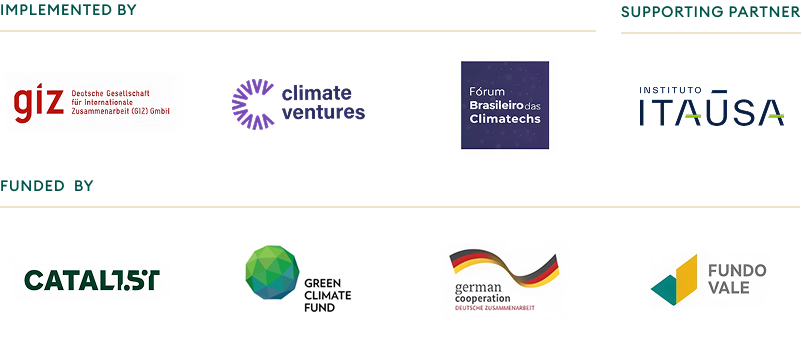Fractured Foundation
The ecosystem lacks institutional orchestrators required to align agendas and build the market with strategic intent.
Brazil stands at a critical juncture where climate innovation converges with sustainable development and its national destiny.
Explorar
The study presents a comprehensive overview of Brazil’s climate tech ecosystem, mapping the opportunities, barriers, and conditions shaping its development. Based on desk research, interviews, and collaborative workshops, the report identifies structural gaps, key actors, and dynamics among entrepreneurs, investors, and public institutions. As an evolving field, the study continues to advance as new evidence is incorporated, contributing to the strengthening of policies, investments, and actions that drive climate innovation in the country.
Brazil is pivotal in the global climate agenda: unique biodiversity, clean energy mix, and the largest emerging economy in Latin America. Despite its potential, Latin America receives less than 1% of global climate tech investments – USD 743M in 2024 out of USD 92B (Net Zero Insights, 2024).
The findings highlight both opportunity and challenge. The current climatech landscape in Brazil presents a paradox: immense potential constrained by systemic barriers. While the country possesses exceptional conditions for pioneering technology-based climate solutions, the ecosystem remains too nascent and fragmented to turn promise into large-scale impact. Despite the surge in global investment in climate technology, Brazil has captured only a marginal share of capital flows—revealing structural bottlenecks, data gaps, and a persistent misalignment among innovators, investors, and enabling institutions.
Climate tech investment reached USD 92B in 2024, but deal volume fell 23%.
Capital diversification: strong rise in debt financing and corporate VC participation.
Concern: declining appetite for early-stage funding, traditionally driven by VCs.
Entrepreneurial leadership: ~18,000 startups mapped (SEBRAE) and top destination for VC capital in Latin America.
Natural advantages: extraordinary biodiversity, rich natural resources, and one of the cleanest energy matrices among G20 countries.
Knowledge & talent: strong network of research centers and highly qualified workforce.s
The challenge goes beyond macroeconomic risk aversion.
Investors frequently point to a “lack of investable climatech pipeline.”
This perception reinforces the funding gap, even as capital is available in later stages
![]()
Brazil’s research institutions are global leaders in biotechnology, forestry, agriculture, energy, and environmental science. The challenge is to convert this deep scientific base into investable, market-ready climate solutions.
![]()
The government has established a strategic framework through the Ecological Transformation Plan, the Green Taxonomy, and the Brazilian Emissions Trading System (SBCE). These tools can transform public policy into a market-creating engine for climate innovation via mechanisms like public procurement and the Climate Fund.
![]()
Brazil holds a competitive advantage in developing globally relevant technologies and nature-based solutions (e.g., bio-based materials, precision agriculture, REDD+). This positions Brazil as a global exporter of climate solutions, enhancing its geopolitical relevance.
The ecosystem lacks institutional orchestrators required to align agendas and build the market with strategic intent.
Innovators face regulatory complexity in highly regulated sectors (energy, water, agriculture). Flexible frameworks, such as sandboxes or simplified certification, remain underutilized.
Available financing is fundamentally misaligned with the risk profiles and timelines of climatech ventures. The financial architecture lacks climate-specific instruments like concessional capital and blended finance.
Many founders do not self-identify as “climatech,” which erodes the sector's visibility, credibility, and investability.
Unlocking Brazil’s potential requires articulation and joint action across three dimensions—private, public, and ecosystem—relying on the simultaneous execution of these complementary pathways.
Use the three provided visual diagrams as the main anchors for each dimension, placing them prominently alongside short descriptions summarizing the role and number of actions.

Must de-risk innovation and shape the regulatory, financial, and institutional environment through strategic policies and capital. Involves 7 key actions.
Private Sector Role: Scaling Climatech Diagram

Must redesign its institutional infrastructure for climate finance. Involves 7 key actions.
Public Sector: Enabling Climatech Development Diagram

Focuses on building an enabling ecosystem that connects, legitimizes, and amplifies innovation. Involves 5 key actions.
Ecosystem Strengthening: Building Enabling Infrastructure Diagram
The final recommendations, conclusions, and full downloadable report will be available after its official launch on November 17 at COP 30. Sign up for our newsletter to get early access!
 Join the Green transition
Join the Green transition

Daniel Contrucci
Ude Lottfi
Severin Peters
Pedro Camarote
Ana Himmelstein Capelhuchnik
Zé Gustavo Fávaro Barbosa Silva
Amanda Magalhaes
Ana Himmelstein Capelhuchnik
Laura Fostinone
Zé Gustavo Fávaro Barbosa Silva
Sauradeep Bhattacharyya
Milena Stolz
CATAL1.5°T branding guidelines
Flavia Ferreira
Reviso Lab
This study was made possible thanks to the support of our partners and funders. We are especially grateful for the strategic partnership of GIZ and Fundo Vale as well as the support of Instituto Itaúsa, in addition to long lasting collaboration between Climate Ventures and the Brazilian Forum of Climatechs.
